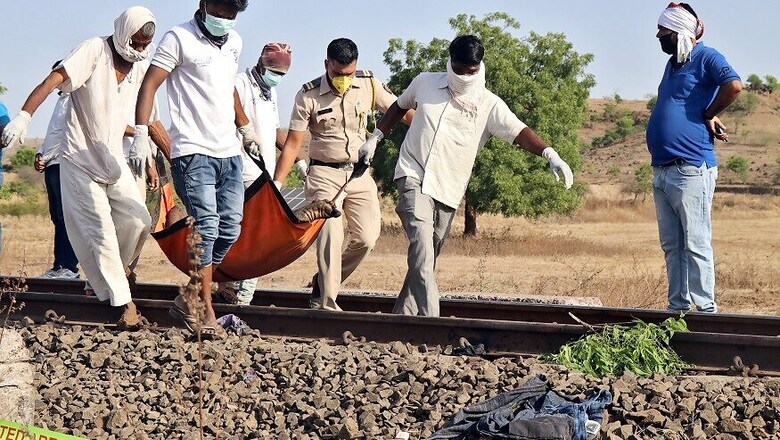
views
New Delhi: By 2016, India had nearly 10 crore internal migrants. In other words, nearly every third person out of India’s workforce was migrating away from state of origin to search for livelihood. This was what the then Chief Economic Advisor Arvind Subramanian had said in his Economic Survey of 2016-17, in a chapter titled “India on the Move and Churning: New Evidence”. Even if one ignores the obvious increase in these numbers since, the assertion by Finance Minister Nirmala Sitharaman on Wednesday morning about the government having little data on migrants is perplexing.
Subramanian had said that the share of migrants in the total workforce was between 17% and 29% or every third person from the total Indian workforce could be a migrant. As per Census 2011, the size of the workforce was 482 million so he said it was safe to assume that this had crossed 500 million by 2016.
If the share of migrants in the workforce was estimated to be even 20% (not the upper limit of 29%), the size of the migrant workforce would have been over 100 million or 10 crore in 2016, as per Subramanian. The former CEA had examined the numbers as per Census 2011 and then used other data sources, including data on unreserved train passenger travel every month, to come to a conclusion about how many people were moving away from their home states for work etc.
So when Sitharaman said in an interview that she wished the government had enough data on migrants to provide direct assistance to them, it seemed obvious that the lack of an estimation cannot be the reason for this inability to reassure the masses hitting highways, gathering in large numbers at grounds, desperate to find a way to reach home.
“The motive is not to exclude. Tell me (does) anybody — state governments, the Central government, local bodies, universities, think tanks, institutions which monitor our economy — have a comprehensive database on migrant workers? I am not blaming anybody. For me to say, that is the prototype, that is the state where this many migrants are there, they spend across the state, they may be from xyz sectors and if that’s the proportion, I might be able to do a model of xyz or abc states…But where is it, where is the data, who is there as a migrant? Without that however much relief and however much you want to give, I don’t even have a basis and won’t know how to reach them, institutionally,” Sitharaman said.
She further said that states and other local bodies will be roped in to form a database on migrants. But the problem at present may actually be that the lockdown came as a hammer blow, with just not enough time and no consideration of the plight of this class of people whose livelihoods are often dependent on functioning cities and who have zero safety nets. Caught by surprise, with visuals of migrants streaming onto the streets suddenly erupting across media, the government took time getting its act together. Some economists and Opposition leaders suggested that handing over a significant amount of cash to the destitute, with or without documents and with no questions asked, could help mitigate their troubles.
But the government was able to only put Rs 500 in the existing Jan Dhan accounts under the PM Garib Kalyan Yojana, offering nothing to the unbanked. And by the time the FM gave us an estimate of eight crore migrants who were to be offered free foodgrain for two months, most were already on the long march home. Where can they stop by to access these rations? Hungry and thirsty, many continue to lose their lives as they try any means to reach a place of safety.
This situation was exacerbated by the lockdown, but the honest truth is that few attempts have been made to reach this highly vulnerable section of society in the past. Earlier, Union Labour minister Santosh Gangwar had said in Parliament in March that neither did the government have an estimate for internal migrants nor has it conducted any study to assess the living standard, health and safety of migrant workers.
The minister was replying to queries by MPs on how many migrants exist in the country, whether their safety and health is monitored by the government and is the implementation of the ‘Inter State Migrant Workmen Regulation of Employment and Conditions of Service Act, 1979’ monitored by the Centre.
The people who nobody documented, have been left to fend for themselves in better times as well as now, in times of great distress. The absence of data makes it near impossible to reach these people for any assistance. Nor is there further assessment of the kinds of assistance these people may need in terms of food, healthcare, cash transfers etc.
In an echo of the same helplessness that we detect in Sitaraman’s interview, Gangwar had said in his reply that migration of workers from one area to another area was a “continuous process and the migrant workers keep on moving from one area to another area in search of work, therefore, it is not feasible to keep record of such migration.”.
Now, as the Congress gets active on the issue of the imploding migrant crisis, the Chairperson of its Data Analytic Team, Praveen Chakraverty, said his estimate was a migrant population of over four crore people who were currently in other cities for work.
“According to my estimate, there are over four crore migrants currently in other cities/towns for work. What percent of them wants to move back varies with time. Proxy data sources can be used to impute a rough estimate. Among other things, I suggest the government first read the Economic Survey report of its own CEA on migration”.
The government may have now reactively started collecting data on migrants but this step has come too late for those dying on railway tracks and highways.
In the Survey nearly four years back, Subramanian had noted that migration within India was between 5-9 million or just shy of upto a crore annually; less affluent states and districts evinced higher out-migration and rich metropolises attracted large inward flows.
Internal migration nearly doubled in the 2000s relative to the 1990s and increased migration happened despite discouraging incentives such as domicile provisions for working in different states, lack of portability of benefits, legal and other entitlements upon relocation.
Sitharaman did not have to look far if this government indeed wanted to do something for the migrants. Subramanian had said in that Survey “To sustain this churn, however, these policy hurdles have to be overcome. Portability of food security benefits, healthcare, and a basic social security framework for the migrants are crucial – potentially through an interstate self-registration process. While there do currently exist multiple schemes that address migrant welfare, they are implemented at the state level, and hence require inter state coordination of fiscal costs of migration.”




















Comments
0 comment